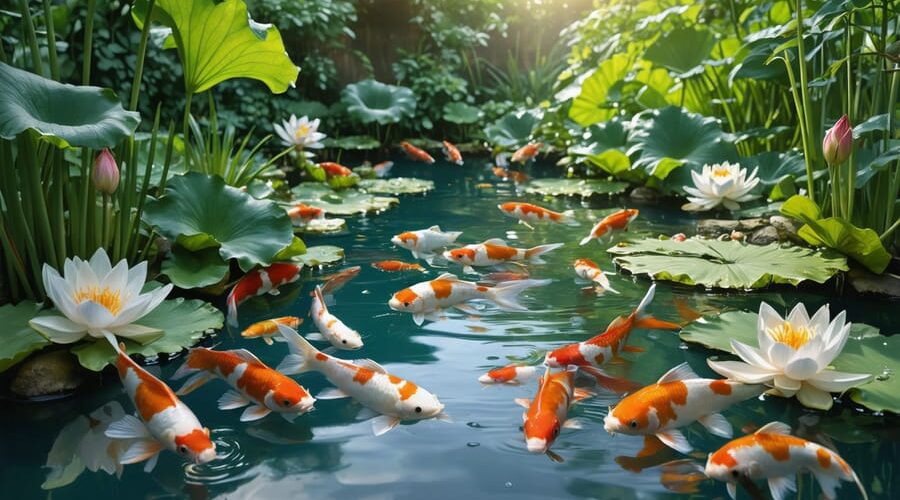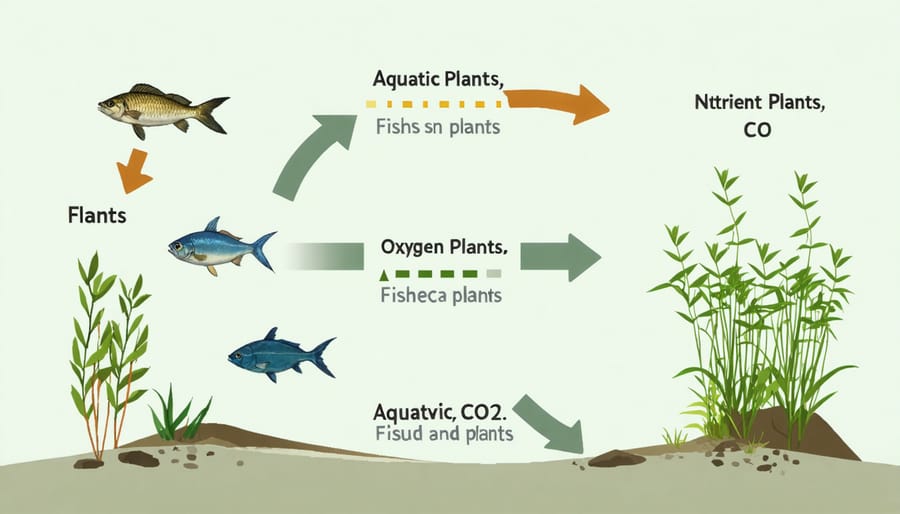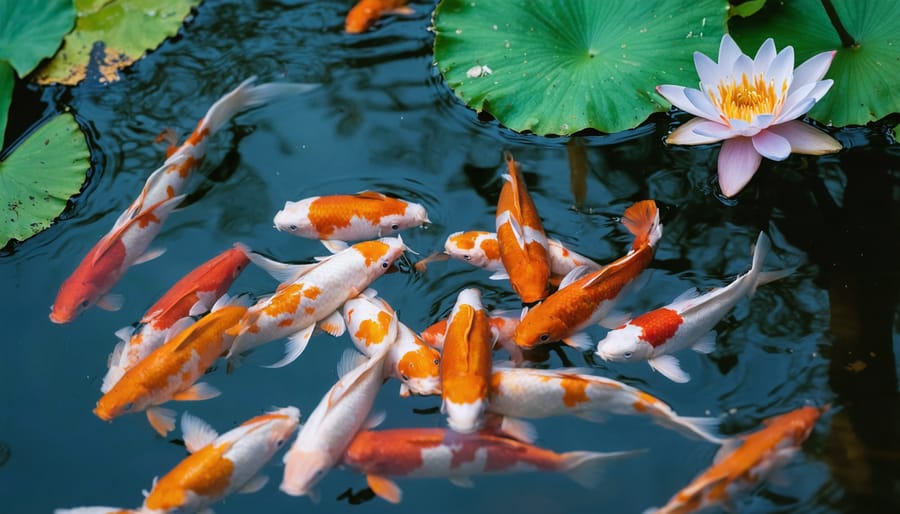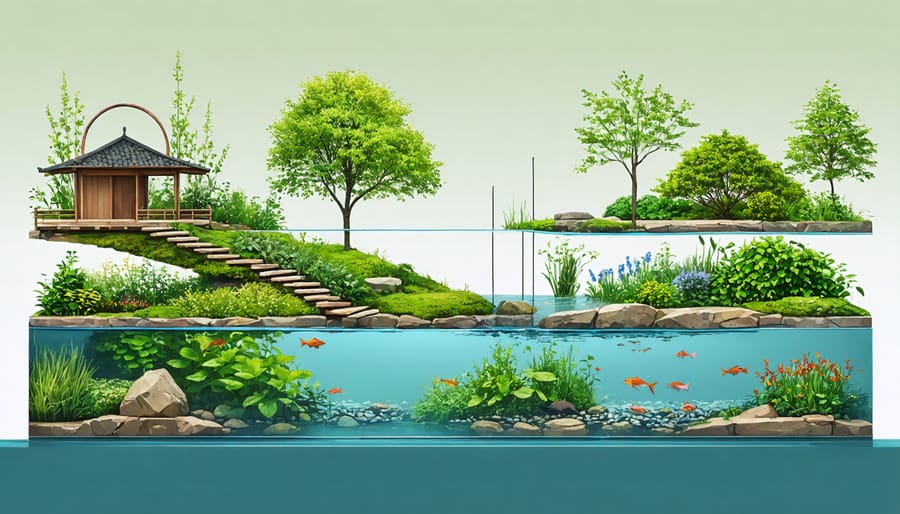
Perfect Pond Balance: How Fish and Plants Work Together for Crystal Clear Water
Transform your backyard pond into a balanced ecosystem by strategically combining fish and aquatic plants that support each other’s growth. Position floating plants like water lilies and lotus to cover 40-60% of the water surface, creating essential shade for fish while naturally filtering excess nutrients. Stock your pond with compatible fish species such as koi and goldfish at a ratio of one inch of fish per 10 gallons of water to maintain optimal water quality. Layer different types of plants – submerged oxygenators, floating varieties, and marginal species – to create a natural filtration system that keeps water clear and fish healthy. This dynamic relationship between pond fish and plants mirrors nature’s perfect design, where each element plays a crucial role in maintaining water quality, controlling algae growth, and creating a thriving aquatic environment that delights the senses and requires minimal maintenance.
The Natural Cycle: Understanding Fish and Plant Relationships

How Fish Benefit Plants
Fish and plants create a perfect partnership in your pond, working together in a natural cycle that benefits both. When fish swim and feed, they produce waste that acts as a natural fertilizer for your aquatic plants. This waste contains nitrogen and other essential nutrients that plants need to grow strong and healthy. Think of it as nature’s own fertilizing system!
But that’s not the only way fish help your plants thrive. As fish breathe, they release carbon dioxide (CO2) into the water. Plants use this CO2 during photosynthesis, converting it into oxygen and food for themselves. This process helps keep your pond water clean and well-balanced while providing your plants with a constant supply of what they need to flourish.
The movement of fish through the water also helps distribute these nutrients evenly throughout your pond. When fish swim near plant roots, they stir up settled nutrients from the bottom, making them more accessible to the plants. This natural interaction creates a self-sustaining ecosystem where both fish and plants can thrive with minimal intervention from you.
How Plants Support Fish Health
Pond plants play a vital role in supporting fish health through several natural processes. First, they’re incredible oxygen producers, especially during daylight hours when photosynthesis is in full swing. This oxygen-rich environment helps fish breathe easier and maintain their energy levels throughout the day.
Plants also provide essential natural filtration by absorbing excess nutrients and harmful compounds from fish waste. Water lilies, for instance, are particularly good at removing nitrogen and phosphates, which helps prevent algae blooms that could harm your fish.
Just like we enjoy a cozy home, fish need places to hide and rest. Submerged plants create perfect shelters where fish can escape from bright sunlight or hide from predators. These plant-created hideaways are especially important for young fish and during breeding seasons. The leaves and stems also provide surfaces where beneficial microorganisms can grow, contributing to a healthier ecosystem for your finned friends.
Think of plants as your pond’s natural life support system – they’re not just pretty additions but essential partners in keeping your fish happy and healthy!
Best Fish and Plant Combinations for Your Pond
Koi and Water Lily Combinations
Creating successful koi and water lily combinations requires careful consideration, as these magnificent fish can sometimes disturb aquatic plants. However, with the right approach, you can create a stunning and harmonious pond environment that benefits both.
Hardy water lilies are your best choice for koi ponds, as they can withstand the fish’s curious nature. Varieties like ‘Attraction’ (red), ‘Charlene Strawn’ (yellow), and ‘Perry’s Baby Red’ have sturdy stems and leaves that resist damage. Plant them in deep containers (12-15 inches) and place them in areas where the water is at least 2-3 feet deep to protect the roots from nibbling koi.
To create a balanced ecosystem, surround your water lilies with complementary plants. Marsh marigolds and iris work well along the pond edges, while floating plants like water lettuce can provide additional shelter for your koi. Just remember to keep floating plants to about 30% of the water surface to ensure proper oxygen exchange.
For best results, position water lilies away from fountain sprays and waterfalls, as koi tend to be more active in these areas. Consider adding rock barriers around plant containers to discourage koi from disturbing the soil. Start with mature plants rather than young ones, as established plants are more resilient to fish activity.
Regular maintenance is key – trim yellowing leaves promptly, divide water lilies every 2-3 years, and ensure your pond has adequate filtration to handle both plant debris and fish waste. With proper planning and care, your koi and water lilies can thrive together, creating a beautiful and balanced water garden.

Goldfish and Plant Partnerships
Goldfish and aquatic plants create a perfect partnership in your pond, with each supporting the other’s well-being. When selecting plants for your goldfish pond, consider species that serve multiple purposes: providing natural shelter, helping maintain water quality, and offering occasional snacks for your finned friends.
Floating plants like water lilies and lotus create essential shade spots where goldfish can retreat from the hot sun. Their broad leaves also help reduce algae growth by limiting light penetration. For added protection, consider submerged plants such as hornwort and anacharis, which provide excellent hiding spots for goldfish while naturally oxygenating the water.
Along the pond’s edge, marsh marigolds and iris not only add beautiful color but also help filter the water through their root systems. These marginal plants create natural barriers that protect goldfish from predators while adding vertical interest to your pond design.
For a practical touch, include plants that goldfish can safely nibble on, such as duckweed and water lettuce. These fast-growing floating plants help absorb excess nutrients from fish waste while providing a natural food source. Just remember that goldfish can be enthusiastic eaters, so you’ll want to maintain enough plant coverage to prevent them from decimating your floating garden.
To protect young or delicate plants from curious goldfish, consider starting them in separate areas or using plant baskets until they’re established. This approach allows both your plants and fish to thrive while creating a balanced, self-sustaining ecosystem that’s both beautiful and functional.
Maintaining the Perfect Balance
Seasonal Care Tips
As your pond transitions through the seasons, it needs different types of care to maintain a healthy ecosystem. In spring, start by removing debris and dead plant material that accumulated over winter. Test the water quality and gradually reintroduce fish as temperatures consistently stay above 50°F (10°C). This is also the perfect time to divide and replant marginal plants.
Summer requires vigilant monitoring of water levels due to increased evaporation. Add fresh water regularly and keep an eye on algae growth. Floating plants like water lilies help provide necessary shade for fish while keeping water temperatures stable. Feed fish more frequently during this active season, but avoid overfeeding.
Fall brings falling leaves – your biggest challenge. Install pond netting early to catch leaves before they sink and decay. Begin reducing fish feeding as temperatures drop and trim back dying plant material. Consider adding cold-hardy plants that will provide winter interest.
Winter preparation is crucial for both fish and plants. If your pond is deep enough (at least 2 feet), fish can overwinter at the bottom where water remains unfrozen. Move tender tropical plants indoors or treat them as annuals. Keep a small area of the surface ice-free using a pond heater or bubbler to allow for gas exchange. Stop feeding fish when water temperatures consistently drop below 50°F (10°C).
Remember, gradual transitions between seasons are key to maintaining a healthy pond ecosystem.
Common Problems and Solutions
Even well-maintained ponds can face common challenges, but most issues have straightforward solutions. Algae blooms are perhaps the most frequent problem, often caused by excess nutrients in the water. Adding more floating plants and reducing fish feeding can help restore balance. If your fish seem lethargic or are gasping at the surface, this usually indicates low oxygen levels – consider adding an aerator or waterfall feature.
Yellow or browning plant leaves typically signal nutrient deficiencies. Try adding aquatic plant fertilizer tablets near the roots, but be careful not to overdose. If fish are nibbling on your plants excessively, create protected areas using rocks or add more plant varieties to distribute their attention.
Cloudy water often results from overfeeding or overstocking. Reduce feeding amounts and ensure you’re not exceeding the recommended fish population for your pond size. For plants that aren’t thriving, check their planting depth – different species need different depths to flourish.
Sudden fish deaths might indicate poor water quality. Regular water testing and partial water changes can prevent this issue. If plants are being uprooted by fish, secure them better with larger rocks or planting baskets. Remember that most problems develop gradually, so regular monitoring helps catch issues early when they’re easier to resolve.
Plant Placement for Fish Well-being

Creating Fish-Friendly Zones
Creating fish-friendly zones in your pond is all about strategic plant placement that provides shelter, shade, and natural hiding spots for your aquatic friends. Start by placing taller marginal plants like rushes and iris along the north side of your pond, which creates shade without blocking too much sunlight from reaching the water.
Underwater plants should occupy about 50-60% of your pond’s surface area, creating a natural labyrinth where fish can hide from predators and find relief from summer heat. Consider placing clumps of oxygenating plants like hornwort or anacharis in different depths, creating multiple “safety zones” throughout the pond.
Floating plants like water lilies offer excellent cover for shy fish while helping to maintain cooler water temperatures. Arrange them in small groups rather than spreading them evenly, leaving open swimming channels for your fish to navigate through. This natural layout mimics their habitat in the wild and reduces stress.
Don’t forget to create shallow shelves near the pond’s edge where fish can retreat during cold weather. Plant these areas with low-growing marginal plants that provide additional cover without overwhelming the space. Remember to leave some open areas for feeding and observation – after all, watching your fish is part of the joy of pond keeping!
For the best results, combine different plant heights and growth patterns to create a varied underwater landscape that gives your fish plenty of options for exploration and shelter.
Plant Density Guidelines
Getting your plant density right is crucial for a healthy pond ecosystem. As a general rule, aim to cover 50-60% of your pond’s surface with plants, leaving plenty of open water for fish to swim and oxygen exchange to occur.
For floating plants like water lilies, allow about 3-4 feet of space between each plant. One lily pad cluster can cover approximately 15-20 square feet when mature. For marginal plants along the edges, space them roughly 1-2 feet apart, depending on their mature size.
In shallow areas, plant bog plants about 6-12 inches apart to create natural-looking clusters. Submerged oxygenating plants should be planted in groups of 3-5 stems per square foot. These workhorses of the pond help maintain water quality and provide shelter for fish.
For vertical plants like cattails or iris, maintain 2-3 feet between specimens to prevent overcrowding. Remember that most aquatic plants grow vigorously, so it’s better to start with fewer plants and add more if needed.
Monitor your plant growth throughout the seasons and thin out excessive growth as needed. Dense plant coverage can reduce oxygen levels and make it difficult for fish to navigate. On the flip side, too few plants might lead to algae problems and leave fish without adequate shelter.
Creating a balanced pond ecosystem is a rewarding journey that brings life and tranquility to your outdoor space. As we’ve explored throughout this guide, the relationship between pond fish and plants is truly remarkable – each supporting the other in creating a sustainable aquatic environment.
Remember that successful pond keeping isn’t about following strict rules, but rather understanding and working with nature’s rhythms. Start small with hardy plants like water lilies and reliable fish species such as goldfish, then expand your collection as you gain confidence. The key is maintaining the right balance: enough plants to provide oxygen and shelter, and the appropriate number of fish for your pond’s size.
Don’t be discouraged if you face initial challenges – every pond keeper has been there! Regular monitoring of water quality, thoughtful plant selection, and responsible fish stocking will help you create a thriving ecosystem. The satisfaction of watching your fish dart between lily pads, hearing the gentle splash of water, and seeing your aquatic plants bloom makes all the effort worthwhile.
Whether you’re planning your first pond or looking to enhance an existing one, remember that patience is essential. Take time to observe how your pond develops and adjusts to changes. With the knowledge you’ve gained from this guide, you’re well-equipped to create your own slice of water garden paradise. Happy pond keeping!
